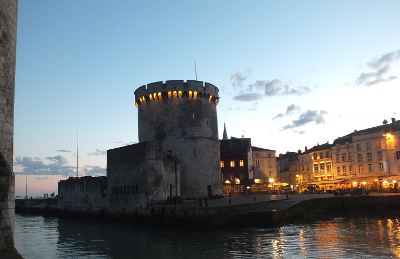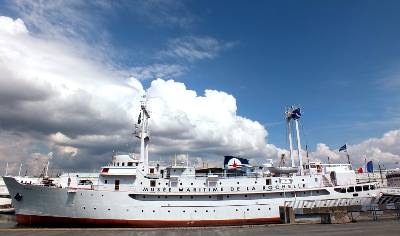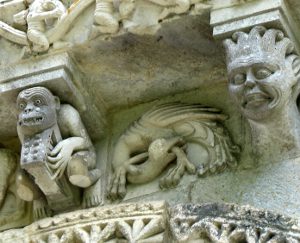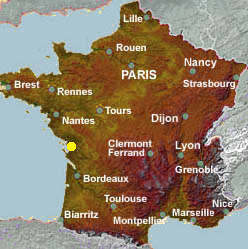
La Rochelle
Historic gateway to the Atlantic
- Explore France ►
- Essential pages
- Travel in France
- Where to go
- What to see and do
About-France.com
- the connoisseur's guide to France
| On this page | Historic La Rochelle | In the area | Hotels in La Rochelle |
Historic La Rochelle
 The floating harbour with
the old city behind.
The floating harbour with
the old city behind.Its importance as a merchant port began in the Middle Ages, when the city became a free port, and began trading with northern Europe. By the 12th century, La Rochelle was a bastion of democracy on the edge of feudal France, a city controlled not by kings or dukes, but by a mayor and aldermen – the first city in France to adopt this new form of governance that was more common in northern Europe.
 Houses
of the old city surrounding the old port
Houses
of the old city surrounding the old portFollowing the siege, most of the ramparts of the old city were demolished - leaving just the towers guarding the old Port, the great lighthouse tower, and the city walls between the two..
In the following years, la Rochelle developed as one of France's great colonial and international trading ports, trading with New France (French north America, including Quebec), the French West Indies, and Africa; but its importance as a port dwindled during the nineteenth century. It was too far from the great industrial centres of Europe, and the port could not take the large vessels of the industrial age.
Today, maritime trade has returned to La Rochelle thanks to a new deep-water port at la Palice; and the old historic basins have been turned over to new uses, including home for a historic ships collection, and a centre for yachting and pleasure craft. With moorings for 3500 yachts, La Rochelle is now the largest yachting marina in France.
Things to see and do in La Rochelle
 The
La Rochelle Maritime museum - on board a historic weather ship.
The
La Rochelle Maritime museum - on board a historic weather ship.The historic centre is a criss-cross of narow streets, many of them closed to vehicles, bordered by medieval and Renaissance houses, built in the distinctive local white limestone. With tourism among the city's main industries, many of the narrow streets, notably those close to the port, are filled with bars and restaurants offering local specialities and cuisine from around the world.
The old city is also remarkable for its streets lined by arcades - some three kilometres of arcades in all. In bygone centuries, the arcades housed the booths of market traders, merchants and money-changers. Today they provide shaded sidewalks in front of cafés, boutiques and restaurants.
The finest historic building in the old town is the medieval town hall, or Hotel de ville; this was the seat of the governor or mayor in medieval times, and is the oldest town hall in France, though it was extensively renovated and embellished in the nineteenth century. Sadly, in October 2013, a huge fire engulfed the building, and the roofs caved in. The building is now being painstakingly rebuilt and is scheduled to reopen in 2019 or 2020. From the outside, it will seem as it was; though inside, even if many of the most important artefacts were saved, much of the earlier structure has been lost.
While much of the pleasure of la Rochelle is just to wander round the port, enjoy the cafés and restaurnats, and perhaps take a boat trip to the Island of Ré, the city has a number of other attractions, the most important of which is its Aquarium, situated beside the Floating Harbour. This is one of the largest in Europe, and is a showcase for the private company in La Rochelle that is one of the major specialist aquarium builders in Europe.
Just a few hundred metres from the Aquarium is the La Rochelle Maritime Museum, located on board a ship called the France 1, which spent many years as a stationary weather ship and beacon out in the Atlantic ocean.
There is also a Museum of Automata and small scale models, located in the Minimes district, west of the Old Harbour, and in the town centre "The Bunker", a Second world war museum, including a German submarine command bunker which has remained more or less intact. La Rochelle was at the time a major German U-boat base, and the bunker, as well as being a well preserved item from the war, tells the history of La Rochelle under German occupation.
In addition to these four distinctive museums, La Rochelle has a number of smaller museums, including a natural history museum, an art gallery (mostly French art, including views of the port of La Rochelle by Signac and Marquet.), and a museum of the New World.
In the area - Around La Rochelle
Rochefort
 Historic
rope-twining machinery in the Ropeworks
Historic
rope-twining machinery in the RopeworksNext to the Royal Ropeworks is the dock that is the home berth of the "Hermione", a magnificent replica of the 18th century frigate on board which General Lafayette crossed the Atlantic to help the Americans in their war of independence against the British. Being a seaworthy ship, the replica is not always present in Rochefort. For information visit the official site of the Hermione association.
A short distance from the Ropeworks is a unique industrial heritage site, the Rochefort transporter bridge over the river Charente. though no longer in use, this is one of the rare surviving examples of transporter bridges in Europe, and the only one in France.
Another intriguing place to visit in Rochefort is the house of Pierre Loti, a famous 19th century French traveller and writer. During his travels, Loti acquired a large collection of artefacts from North Africa and the Middle East, and brought them back to Rochefort, where he used them to create exotic rooms in the family mansion: these include a finely decorated 16th century mosque, largely bought in Syria and reassembled in Rochefort.
Saintes and the Saintonge
 12th century
Romanesque sculptures on a Saintonge church.
12th century
Romanesque sculptures on a Saintonge church.Ile de Ré
A small island connected to
the mainland by a toll-bridge just north of
La Rochelle, the Isle of Rhé is a very popular tourist
destination, famous for its sandy Atlantic beaches. Even if, in summer,
it can get quite crowded, there is plenty of room for all to enjoy its
kilometres of sandy beaches and two small
ports.
The port of Saint Martin is like a small version
of La Rochelle, enclosed behind seventeenth century ramparts designed
by Vauban, and part of the Vauban UNESCO world heritage site.
Location and access
La Rochelle is located half way down the Atlantic coast of FranceAccess:
By plane - Nearest airports: La Rochelle, Limoges, Bordeaux
By road : La Rochelle is 7 hours drive from Calais, 5½ hours from Paris, and 2 h from Bordeaux.
By train: Train station La Rochelle .
Direct TGV services from Paris Gare Montparnasse (3hr 15), and Intercity services from Bordeaux (2h 15) For timetables and online tickets, see Trainline.com .
About-France.com
Home page -
Site search
- Regions
- Maps of France
- Contact
Photo top of page : La Rochelle - the old port.

Nouvelle Aquitaine - Poitou-Charentes
Nearby cities: Angoulême, Poitiers, Bordeaux
Urban area Population 209,000
Nearest airports: La Rochelle, Poitiers, Bordeaux
Main sites: the Old Port, the Maritime Museum, the Aquarium, the old city.
Nearby attractions: Rochefort, Ile de Ré, Saintes, Cognac
This well-reviewed two-star hotel stands beside the Old Port in the centre of La Rochelle. Public parking nearby
Hotel Saint Nicolas ★★★
Located in the heart of the old town, close to the old port and in a quiet side street. The rooms are reasonably spacious though not vast, and the the hotel is very clean and welcoming. There is internal parking if reserved in advance.
Hotel Mercure Vieux Port ★★★★
Modern four-star hotel beside the old Fishing Port, and next to the Aquarium
Hotel Altica ★★
Modern two-star hotel in the Minimes district, 200 metres from the Maritime Museum, and in easy walking distance of the Old Port, aquarium and other attrctions.
Modern
hotels on the outskirts of La Rochelle.
B&B hotel Beaulieu Puilboreau ★★
Modern 2 star hotel beside the N11 main road into La Rochelle. Free parking onsite
About-France.com is an independent user-supported website, and may receive commission from sales made on selected partner websites accessible through affiliate links.

La Rochelle's medieval lighthouse - the only medieval lighthouse left in France
Copyright © About-France.com 2007 - 2025

La Rochelle in a nutshell
Region:Nouvelle Aquitaine - Poitou-Charentes
Nearby cities: Angoulême, Poitiers, Bordeaux
Urban area Population 209,000
Nearest airports: La Rochelle, Poitiers, Bordeaux
Main sites: the Old Port, the Maritime Museum, the Aquarium, the old city.
Nearby attractions: Rochefort, Ile de Ré, Saintes, Cognac
Accommodation in La Rochelle
The
About-France.com selection -
hotels and apartments
hotels and apartments
Traditional hotels in the middle of La Rochelle
Hotel La Marine ★★This well-reviewed two-star hotel stands beside the Old Port in the centre of La Rochelle. Public parking nearby
Hotel Saint Nicolas ★★★
Located in the heart of the old town, close to the old port and in a quiet side street. The rooms are reasonably spacious though not vast, and the the hotel is very clean and welcoming. There is internal parking if reserved in advance.
Modern hotels close to the centre of La Rochelle
Hotel Mercure Vieux Port ★★★★
Modern four-star hotel beside the old Fishing Port, and next to the Aquarium
Hotel Altica ★★
Modern two-star hotel in the Minimes district, 200 metres from the Maritime Museum, and in easy walking distance of the Old Port, aquarium and other attrctions.
Modern
hotels on the outskirts of La Rochelle.
B&B hotel Beaulieu Puilboreau ★★
Modern 2 star hotel beside the N11 main road into La Rochelle. Free parking onsite
More accommodation
About-France.com is an independent user-supported website, and may receive commission from sales made on selected partner websites accessible through affiliate links.
Click here for
low-cost car hire in France
low-cost car hire in France

La Rochelle's medieval lighthouse - the only medieval lighthouse left in France
Copyright © About-France.com 2007 - 2025
